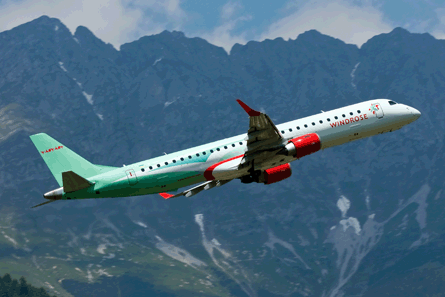Embraer's decision not to follow Bombardier into a head-to-head fight with mainline airliner manufacturers and concentrate on developing an enhanced, re-engined E-Jet instead has been well received by analysts and rivals.
The Brazilian airframer had been evaluating a potential new five-abreast design to compete in the 130- to 160-seat segment. It says it was encouraged to pursue the re-engining option instead having seen how the concept has been accepted by the market, evidenced by the runaway success of Airbus and Boeing's upgraded single-aisles, the A320neo and 737 Max respectively.
"We have seen that with what Airbus and Boeing are doing with the A320neo and 737 Max, the market has accepted re-engining," Eduardo Munhos de Campos, Embraer vice-president for airline marketing in Latin America and the Caribbean, said during the ALTA Airline Leaders Forum in Rio de Janeiro. He added that the business case for re-engining is "more sound with better returns".
 |
|---|
| © AirTeamImages.com Powerplant selection will be crucial to upgrading the twinjet family |
Bombardier is "very pleased" with the Embraer decision, as it means it will not face an all-new rival to the 110- to 145-seat CSeries, which is due to debut in late 2013. "It confirms yet again that we will be the only one who takes the bold step of creating a 100% new airplane in this market segment that needs a new-generation airplane to replace some of the older aircraft," said Philippe Poutissou, vice-president for marketing at Bombardier Commercial Aircraft.
"Secondly, it points to Embraer's recognition that if they want to be competitive in the future, they need to do something [with the E-Jet]."
DEEP POCKETS
Analyst Les Weal, director of valuations and appraisals at Flightglobal's data and consultancy arm Ascend, thinks Embraer's decision is the right one. "Taking on Airbus and Boeing is for the brave or those with very deep pockets," he said. "Life has just got tougher for the competition, such as the Mitsubishi MRJ and CSeries CS100."
Embraer has sold 1,100 E-Jets and delivered about 800 aircraft. The backlog represents around three years' production at current output rates. "The market has embraced E-Jets and it appears that airlines are content with re- engined products," said Weal.
Teal Group's vice-president of analysis Richard Aboulafia believes there was never a case for Embraer to develop an all-new airliner, but that the re-engining plan is a smart one. "This will destroy the CS100 and damage the CS300, and may even impact the 737-7 and A319neo," he said.
"Even the baseline [Embraer] 190 has a lower weight per seat than the CS100. Couple that with a similar engine getting better performance and possibly similar range, which would be even more concerning. Add all that together and the argument for the CSeries goes away.
"Right now, Bombardier's main advantage is timing and that, by definition, is perishable. It's also pretty clear that [Bombardier] is going to be late [with the CSeries]," Aboulafia added.
With Embraer aiming for service entry of a re-engined E-Jet in late 2017 or early 2018, it intends to finalise its strategic direction by early next year, said Munhos de Campos. It will then begin defining the upgrades. Central to this will be selection of an engine to replace the General Electric CF34. "The engines that the manufacturers have available are all offering around 15% lower fuel burn," her said.
Other enhancements under evaluation include a composite fuselage - although aluminium supplier Alcoa has just agreed with Embraer to support "development of new high-performance metallic fuselage and wing solutions" - and a possible stretch beyond the 110- to 120-seat Embraer 195.
The E-Jet family, which straddles the 70- to 120-seat sector, has a four-abreast cabin. Embraer had been considering a large fuselage cross-section for the all-new aircraft to enable a five-abreast configuration like the CSeries, more suited to a family in the 130- to 160-seat sector.
Speaking at the Dubai air show, Embraer's commercial aviation president Paulo Cesar Souza e Silva said that while GE was the "natural incumbent" engine provider, the airframer is keen to talk to other suppliers "to see what they're offering".
ALTERNATIVE POWER
While GE is developing an advanced turbofan in the same power class as the E-Jet's CF34-10, called "Passport", Ascend senior analyst George Dimitroff sees Pratt & Whitney's PW1000G geared turbofan as a potential candidate, with the smallest variant of the engine that powers the MRJ.
"The CF34-10E is 57in [145cm] in diameter, the PW1215/1217G is actually 1in smaller at 56in," he said. "With some space to spare under the wing the engine could even grow a little, which might improve the efficiency over the MRJ."
Carriers, including Brazilian E-Jet operator Azul, have expressed interest in a re-engined version. Azul does not plan orders for new aircraft until 2015, said chief David Neeleman, giving it the option of considering the modified type.
Source: Flight International
















